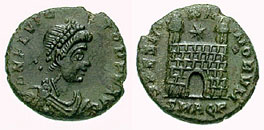Aquileia
Aquileia was an ancient Roman city in what is now Italy. Founded in 181 BC, it was originally established as a colony to prevent barbarian invasions. Over time, Aquileia grew to become an important military stronghold and a significant hub of trade and commerce in the Roman Empire. Its strategic location at the head of the Adriatic Sea, near the rivers Natiso and Ausa, facilitated the growth of its port, which played a crucial role in trade between the Romans and the peoples of Central and Eastern Europe.
History[edit | edit source]
The foundation of Aquileia was part of a larger strategy by the Roman Republic to secure its northeastern borders and to exert its influence over the region. The city's military importance was highlighted during the Cimbrian War, where it served as a base for Roman operations. Aquileia's significance continued to grow, and it became a major crossing point and hub for trade routes linking Rome with the Balkans and the East.
During the Roman Empire, Aquileia was one of the wealthiest cities in Italy, renowned for its magnificent buildings, including a large forum, an amphitheater, and luxurious private residences. The city was also an early seat of Christianity and played a significant role in the spread of the religion in the region. The Basilica of Aquileia, with its stunning mosaics, is a testament to the city's importance in early Christian history.
However, Aquileia's prosperity made it a target for invasions. It was sacked by Attila the Hun in 452 AD, a devastating event that led to the city's decline. Although it was rebuilt, Aquileia never regained its former glory. In the subsequent centuries, it faced further destruction during the Gothic Wars and was eventually overshadowed by the rise of nearby Venice.
Archaeological Significance[edit | edit source]
Today, Aquileia is a UNESCO World Heritage Site, recognized for its archaeological remains, which offer invaluable insights into Roman urban planning, architecture, and daily life. Excavations have uncovered extensive ruins, including parts of the forum, the river port, and early Christian churches. The mosaics of the Basilica of Aquileia are among the most significant and best-preserved examples of early Christian art in Europe.
Legacy[edit | edit source]
The legacy of Aquileia lives on through its archaeological remains and the historical and cultural insights they provide. The city's history reflects the broader narrative of the Roman Empire's expansion, its interactions with various peoples and cultures, and the spread of Christianity. Aquileia's decline and eventual fall mirror the fate of the Western Roman Empire itself, marking the end of an era and the beginning of the Middle Ages in Europe.
Search WikiMD
Ad.Tired of being Overweight? Try W8MD's physician weight loss program.
Semaglutide (Ozempic / Wegovy and Tirzepatide (Mounjaro / Zepbound) available.
Advertise on WikiMD
|
WikiMD's Wellness Encyclopedia |
| Let Food Be Thy Medicine Medicine Thy Food - Hippocrates |
Translate this page: - East Asian
中文,
日本,
한국어,
South Asian
हिन्दी,
தமிழ்,
తెలుగు,
Urdu,
ಕನ್ನಡ,
Southeast Asian
Indonesian,
Vietnamese,
Thai,
မြန်မာဘာသာ,
বাংলা
European
español,
Deutsch,
français,
Greek,
português do Brasil,
polski,
română,
русский,
Nederlands,
norsk,
svenska,
suomi,
Italian
Middle Eastern & African
عربى,
Turkish,
Persian,
Hebrew,
Afrikaans,
isiZulu,
Kiswahili,
Other
Bulgarian,
Hungarian,
Czech,
Swedish,
മലയാളം,
मराठी,
ਪੰਜਾਬੀ,
ગુજરાતી,
Portuguese,
Ukrainian
Medical Disclaimer: WikiMD is not a substitute for professional medical advice. The information on WikiMD is provided as an information resource only, may be incorrect, outdated or misleading, and is not to be used or relied on for any diagnostic or treatment purposes. Please consult your health care provider before making any healthcare decisions or for guidance about a specific medical condition. WikiMD expressly disclaims responsibility, and shall have no liability, for any damages, loss, injury, or liability whatsoever suffered as a result of your reliance on the information contained in this site. By visiting this site you agree to the foregoing terms and conditions, which may from time to time be changed or supplemented by WikiMD. If you do not agree to the foregoing terms and conditions, you should not enter or use this site. See full disclaimer.
Credits:Most images are courtesy of Wikimedia commons, and templates, categories Wikipedia, licensed under CC BY SA or similar.
Contributors: Prab R. Tumpati, MD




